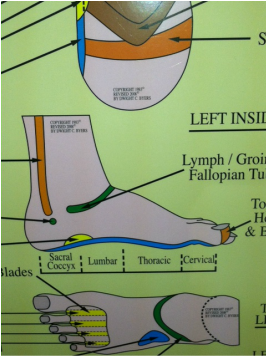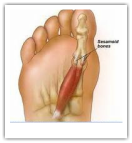
An example of this would be someone who comes in with low back pain, or what some describe as Sciatica. Two items would be checked in the foot, first I would palpate along the ridge of the heel to locate the approximate spot on the back that is triggering the reflex point, and secondly the balance of the foot so that there is foundational stability.
If one was to look at the foot, the inside arch is formed much like the spine. The big toe has both an outward and inward curve just like the head and neck. The bunion region has an outward curve similar to the upper part of the back and makes a sweeping inward curve similar to the mid and low back. Finally the heel has the outward curve, the same as the tail bone area. What does this all mean to the average person? As we stand and/or walk this region, the inside arch of the foot is meant to receive and distribute the dynamics that are being placed on the skeleton and joints. When the foot is inoperative, that force is transferred to the spine and will normally result in some form of discomfort.
As mentioned in last weeks blog we talked about all of the interconnections of the tissue that connects all of the structures inside the body. Remember that the Fascia starts in the upper part of the skull and continues throughout till it reaches the end of your toes. It restructures itself in many different formats to allow for many forms of compensation. When you hear of someone with Plantar Faciitis this is the tissue that becomes inflamed. It is a common ailment with the symptoms of heel pain when first getting up from either a lying or seated position. It goes away after a few steps but the longer the symptoms are present the longer and more painful each step is. It is also a great indicator that the foot is dysfunctional and not performing its day to day duties. As that inflammation and pain continues the foot becomes more distorted in its attempt to find a proper pattern of movement.
As this dysfunction continues the body needs to adapt to this new pattern of movement and places an unusual stress to the joints superior to the foot, primarily in the beginning, which are the ankle, knee and hip joints. Since this foot pain starts out as a minor inconvenience rest, ice, and anti-inflammatory medication abates the problem. Although there is an attempt to fool the brain, there are two items taking place simultaneously, first the medication is overriding the pain sensation and secondly, the brain is figuring out how to compensate for the dysfunction. What normally causes this problem is a malfunction to the posture's tensegrity. Somewhere in the beginning of this problem the weight shift to the posture was transferred from the heel to the ball or front of the foot. In the body's attempt to re-create proper posture it forced the Fascia to stretch and tried to balance the tension of the lower calf muscle to develop a proper pull on the bones of the leg. This constant stretching and attempted restructuring caused multiple micro tears and this is what causes the resultant inflammation. The posture never rebalances itself but eventually places abnormal stresses on other areas. This is when we normally see the individual in our office for treatment.
As balance is returned to the foot the brains complex restructuring takes place and offers the body relief in another location. This compensatory pattern will continue until the brain has run out of options. This is normally what generates the office visit and the reversing process begins. One of the primary areas the therapist should consider is the regions were compressible forces have been reduced. The principle reason here is that without having an ability to compress the body will make skeletal changes to accommodate this pattern and will normally result in some form of radical difference in how the structure's tension is facilitated.
A primary point of balance is the great or big toe. Underneath this landmark, at the ball of the foot, there are two small bones (sesamoid) that act as a guide for a long tendon that manipulates the toe itself. Some people refer to one of the bones, when it has been displaced for a period of time, as a bunion. The other little bone receives little recognition but is the principle factor in pushing that first metatarsal bone (or the bone leading to the big toe), outward and creating the environment for the previous two bones to calcify and form the bunion. These bones will alter or compensate for postural distortion by what some individuals refer to as pronation of the foot. Balancing these two structures will allow the therapist to completely balance the foot and allow for a better hold and will help stabilize the foundation.
As we continue our journey through the foot and its relationship to the body, these points should give us a all a better understanding of why we have pain. This journey should also give us truly a Reason to HOPE that much of our discomfort is able to be addressed and eventually changed. A class that the Wellness Center and The Gibbons School of Massage Therapy and Integrated Medicine is co-sponsoring will be held on July 17th at 6:30 PM in the Wellness Center. Besides myself there will be two other presenters, Josh Trentine, owner and developer of Overload Fitness, and Lydia Williams who is certified to teach both Fundamental Movement Therapy(sm) and Restorative Yoga. The student will learn the mechanics, strengthen movements, and simple exercises that will help keep the feet healthy. For information call 216-364-0152 or email us at [email protected].
Till next week, remember there is always
a Reason to HOPE!
Dennis

 RSS Feed
RSS Feed
